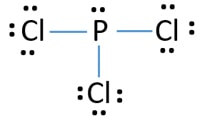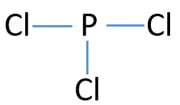PCl3 (Phosphorus Trichloride) Lewis Structure
Phosphorus trichloride (PCl3) contains three chlorine atoms and one phosphorus atoms. In PCl3 lewis structure, each chlorine atom is joint with center phosphorus atom through a single bond. Also, there is a lone pair on phosphorus atom. In this tutorial, we will learn how to draw the lewis structure of PCl3 with all theories.
PCl3 lewis structure

In this lewis structure of PCl3, center phosphorus atom has made three single bonds with three chlorine atoms. There is a lone pair on center phosphorus atom and each chlorine atom also has three lone pairs. Also, there are no charges on atoms in PCl3 lewis structure.
Steps of drawing PCl3 lewis structure
There are guidelines to draw lewis structures. Number of steps can be changed according the complexity of the molecule or ion. Now, we are going to study each step of drawing the lewis structure of PCl3.
- Find total number of electrons of the valance shells of phosphorus and chlorine atom
- Total electrons pairs existing as lone pairs and bonds
- Center atom selection
- Mark lone pairs on atoms
- Mark charges on atoms if there are charges
- Check the stability and minimize charges on atoms by converting lone pairs to bonds to obtain best lewis structure.
Total number of electrons of the valance shells of PCl3
There are only two elements in phosphorus trichloride; phosphorus and chlorine. Phosphorus is a group VA element in the periodic table and has five electrons in its last shell (valence shell). Chlorine is a group VIIA element in the periodic table and contains seven electrons in its last shell.
- valence electrons given by phosphorus atom = 5 * 1 = 5
- valence electrons given by oxygen atoms = 7 * 3 = 21
- Total valence electrons = 5 + 21 = 26
Total valence electrons pairs
Total valance electrons pairs = σ bonds + π bonds + lone pairs at valence shells
Total electron pairs are determined by dividing the number total valence electrons by two. For, PCl3, Total pairs of electrons are thirteen (26/2) in their valence shells.
Selection of center atom of PCl3
There are requirements to be the center atom. Having a high valence and being the most electropositive atom are the most important facts to be the center atom. In PCl3, there are only two elements to select the center atom. So, selecting the center atom is not a hard thing for PCl3.
- Phosphorus's maximum valence is 5. Chlorine's maximum valence is 7. From that fact, chlorine has the high priority to be the center atom.
- Phosphorus's and chlorine's electronegativity values are 2.1 and 3.0 respectively. in this case, phosphorus is more electropositive than chlorine. In this occasion, phosphorus has the highest chance to be the center atom.
- Now, selecting the center atom becomes confusing because we cannot come to a conclusion what is the center atom from above two facts.
- Let's consider valence of phosphorus and chlorine atoms. We know, phosphorus has valence of 3 and 5. Chlorine has valence of 1,3,5 and 7.
- Because phosphorus's minimum valence is 3, there should be at least three bonds around phosphorus atom to fulfill the minimum valence. But, in chlorine, minimum valence is 1. Therefore, sometimes having one bond around chlorine atom is enough to make a covalent compound.
- From above 4 and 5 facts, we can decide phosphorus atom should be the center atom.

Mark lone pairs on atoms of PCl3
After determining the center atom and sketch of PCl3 molecule, we can start to mark lone pairs on atoms. Remember that, there are total of thirteen electron pairs to mark as bonds and lone pairs.
- There are already 3 bonds in the above drawn sketch (three P-Cl bonds). Now only ten (13-3=10) lone pairs are remaining to mark on atoms.
- Usually, those remaining electron pairs should be started to mark on outside atoms. Then, mark lone pairs on chlorine atoms. Each outside chlorine atom will take 3 lone pairs. Now, 9 electron pairs were marked as lone pairs on outside chlorine atoms. So, now there are only one lone pair to mark on rest of the atoms. Mark that lone pair on phosphorus atom.
- Now, all lone pairs have been marked on atoms.

Mark charges on atoms and reduce charges to obtain most stable lewis structure
There are no charges on any atoms. Therefore, we don't need to reduce charges to get the most stable structure. That means, we have already obtained the lewis structure of PCl3.
Questions
How many lone pairs are there on PCl3 lewis structure?
There is only one lone pair on phosphorous atom. But, each chlorine atom has three lone pairs. Therefore, there are total of 9 lone pairs on 3 chlorine atoms. So, in PCl3 lewis structure has 10 lone pairs.
Give some similar molecules to PCl3 lewis structure